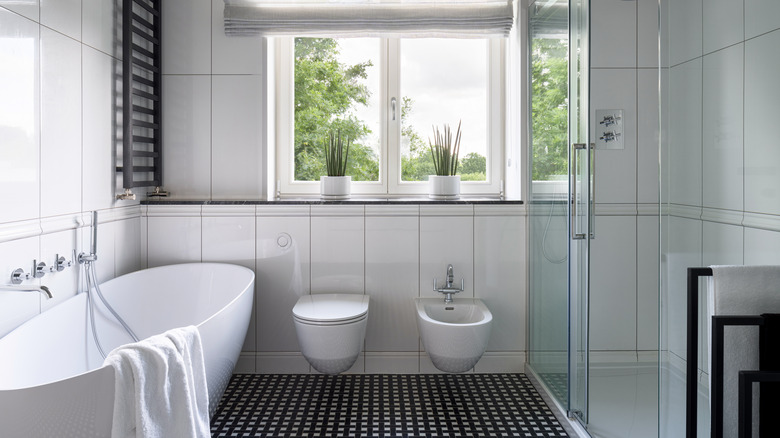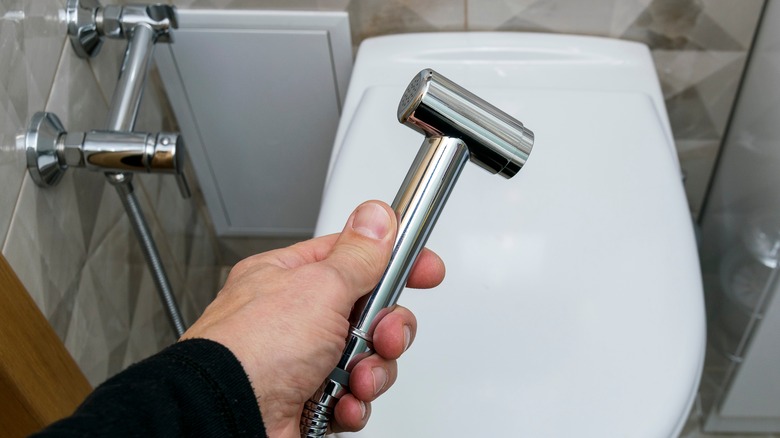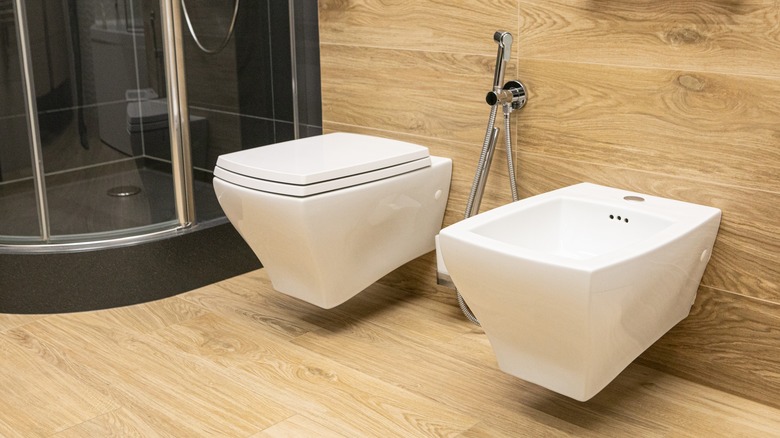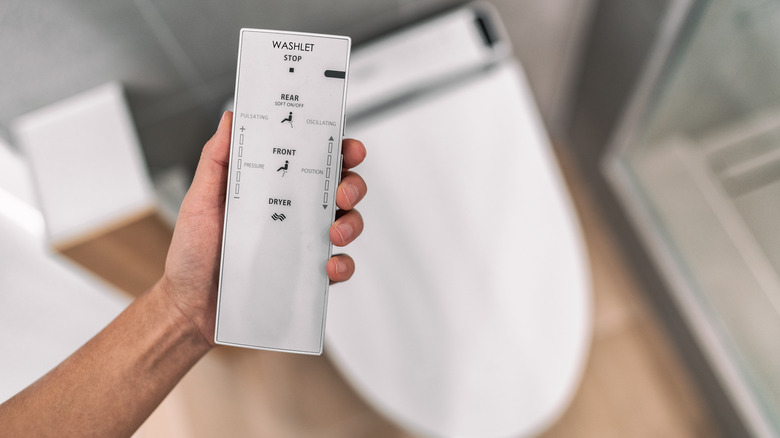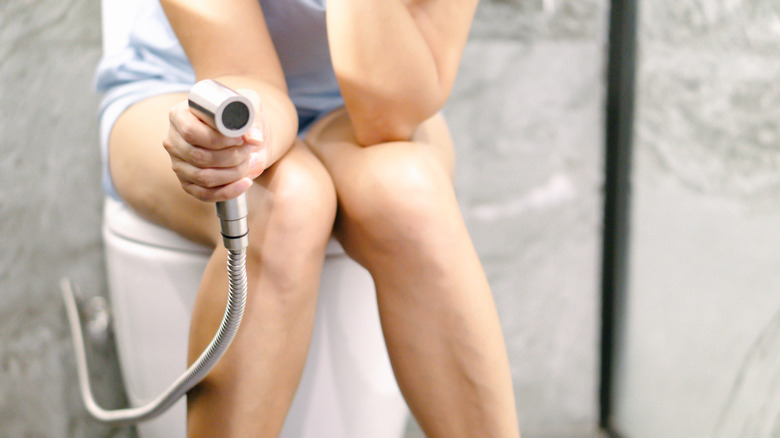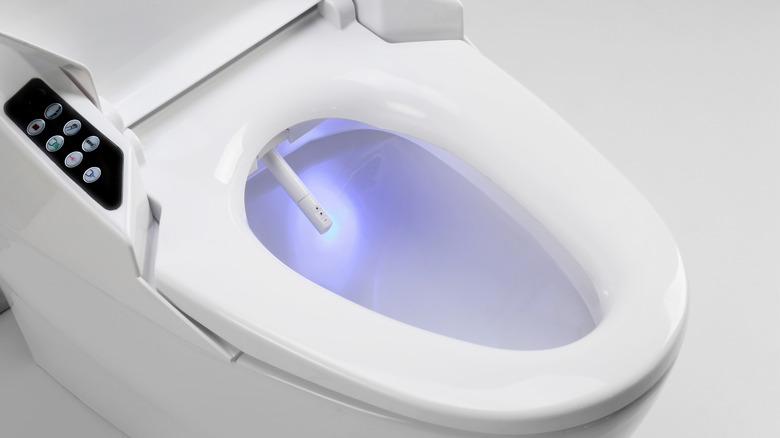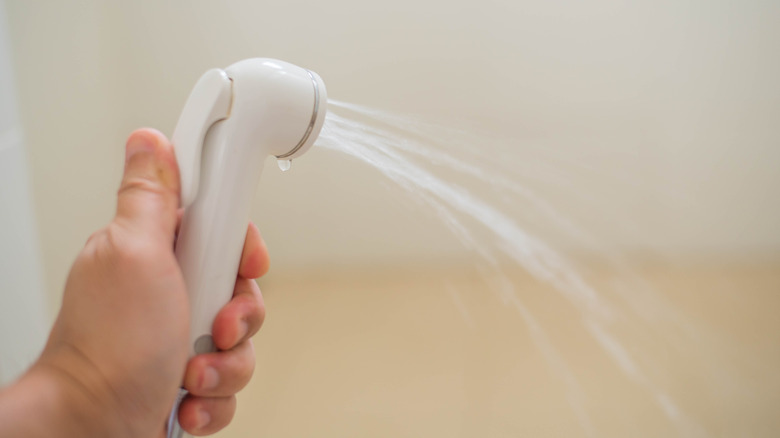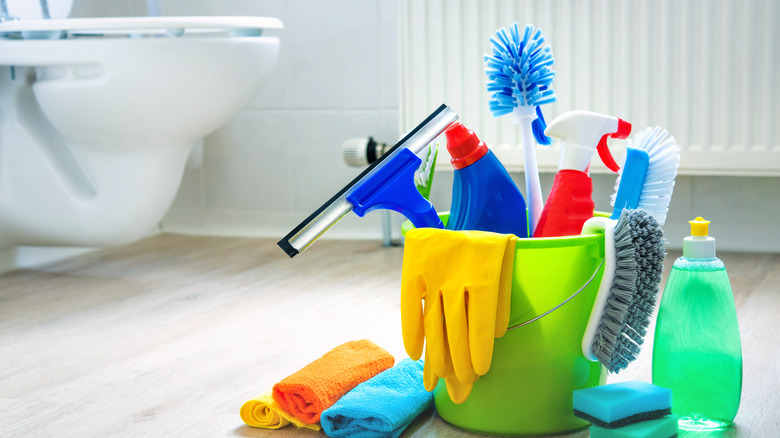The Hidden Downsides To Bidets
According to WebMD, there are several benefits associated with using a bidet. Using a bidet is more hygienic than wiping with toilet paper and can decrease the spread of germs. Using a bidet may even be able to reduce the risk of hemorrhoids. Furthermore, many users even enjoy their time in the bathroom more when using a bidet than wiping with toilet paper.
Bidets are also better for the environment. The World Counts notes that each year 42 million tons of toilet paper — enough to nearly circle the Earth 50,000 times — are used. When more people use bidets, it can have a significant impact on this total. However, despite all these benefits, using a bidet may not be all it's cracked up to be. There are a few downsides to using a bidet that are important to learn about before committing to installing one in your bathroom. Taking a few minutes to read through these downsides can help ensure that you don't end up with buyer's remorse.
It takes some time to get used to using a bidet
If you're not used to a bidet, prepare yourself for a bit of a learning curve. Bathroom Geek shares that you should expect to be a little anxious the first time you use a bidet. After all, it will be a totally new experience. While the exact features of each bidet can vary, Bathroom Geek points out some aspects that will take some getting used to. For one, you'll need to get used to adjust the water pressure and how it feels compared to wiping with toilet paper. Start with the water pressure on a lower level until you get used to how it feels. You'll need to experiment with the nozzle and move it around to find what is most comfortable and practical for you.
Several bidets on the market feature an integrated blow dryer. While this is a premium feature, the first few times you use it may feel a bit strange or even tickle. Also, be prepared to need a bit of toilet paper still to finish drying everything off. Another premium feature included with some bidets is a heated seat. While Bathroom Geek shares that a heated seat is quite comfortable, it will still feel different from what you're used to with a regular toilet.
Freestanding bidets take up about as much space as a toilet
If the idea of a freestanding bidet is appealing, don't get your heart set on one until you confirm it will fit. In many cases, a freestanding bidet will not be a feasible option to add to an existing bathroom. According to HomeServe, they take up approximately the same amount of space as a toilet requires. If your bathroom doesn't seem big enough to fit two toilets, then a freestanding bidet may be out of the question. If you want to try to measure to see if there is sufficient space, you'll need an area that is at least 30 inches wide and 4 feet deep.
Even if there is enough space in your bathroom, there is one other big problem you may run into: plumbing. You will need a hot and cold water supply to hook up a freestanding bidet. Another plumbing consideration is to make sure that a trap is installed beneath the bidet. This is different from what a toilet needs because they include internal traps. Bidets do not, so they will need the trap along with a drain.
Bidets can be expensive
Purchasing and installing a bidet in your home can be expensive. According to Forbes, the average cost to purchase a new bidet is $1,090. However, some models can cost $2,000 or more. The type of bidet you choose will impact the purchase price. Bidet spray attachments are the least expensive options, typically costing between $40 and $60. A bidet toilet seat can cost between $100 and $1,000, and a freestanding bidet may cost between $200 and $600. If you're looking for a bidet toilet — the most luxurious option — be prepared to spend a good deal more. These generally range between $1,000 and $2,000.
In addition to the price of the bidet itself, you'll also have to factor in installation. With freestanding bidets and bidet toilets, in particular, you'll almost certainly want to hire a plumber. Expect to spend another $300 to $600 for the installation. For some bidet toilets, you may also need to hire an electrician for wiring work, which could add an extra $200 or more to your total.
It may take some time for the water to get warm
Depending on the style of bidet you choose, you may have to wait a while for the water to get warm enough to be comfortable. PlumbingSupply explains that some warm water bidets connect to the hot water line in the bathroom. The exact amount of time it will take the water for these units to warm up will vary based on how far the bathroom is from the water heater. Think about how long it takes the water in the shower or sink in the bathroom to get warm to get an idea of how long you may have to wait for the water to warm up.
However, there is a potential workaround to this problem. Before you're ready to use the bidet, you can run off hot water in the sink first. This will bring the hot water into the bathroom's plumbing so that it is ready to come out of the bidet sprayer when you want it. Other warm water bidets have an attached tank that keeps the water warm and ready for use. With these bidets, you'll have warm water whenever you need it. However, if the tank is small, it is possible that the warm water will run out — and be replaced with cold water — while you're finishing up rinsing yourself.
If the power goes out, all the features on an electric bidet will not work
There are both electric and non-electric options available when you're shopping for a bidet seat or bidet toilet. As Bio Bidet by Bemis highlights, there are several benefits associated with choosing an electric model. These models offer premium features such as heated seats, remote control operation, nightlights, automatic opening and closing seats, adjustable nozzles, and air dryers.
However, there is one disadvantage to consider: All of the features on an electric bidet will not work without power. That means that if you lose power due to storms, blackouts, electrical work, or any other cause, your bathroom experience will suffer. Consider different factors that could impact your likelihood of losing power regularly. For example, some regions of the United States are more likely to experience a power outage than others. Generac shared that five states — Michigan, Ohio, New York, Texas, and California — have dealt with more power outages than other states.
Another factor to consider is the increase in powerful storms we've been seeing due to climate change. Climate Central reported that weather-related power outages increased by around 78% in the 10 years between 2011 and 2021 compared to the decade before.
You may need to hire an electrician when installing some bidets
In order to take advantage of all of those benefits of an electric bidet shared above, such as heated seats, remote control operation, and automatic opening and closing seats, you'll need to have an electrical outlet near the bidet. Moreover, not just any outlet will do. BidetKing explains that a ground-fault circuit interrupter (GFCI) protected outlet with a rating of 15 amps or higher is necessary for bidet toilet seats. As Angi shares, GFCI-protected outlets shut off the power if they sense that a person is getting electrocuted. Installing GFCI-protected outlets is especially important in bathrooms, kitchens, laundry rooms, and other areas of a home where water is present.
Cords on most bidet seats are around 4 feet, so you not only need a GFCI outlet in the bathroom, but it should be right behind the toilet. This will help make sure the cord can reach the outlet and will help the cord stay out of sight. Unless you are handy enough to properly install a GFCI-protected outlet behind the bidet, you'll need to hire an electrician to complete the job. Angi says that this will cost about $210.
Bidets can pose a potential health risk for individuals, particularly women
Bidets are often marketed as a more hygienic alternative to wiping with toilet paper. Bio Bidet by Bemis writes that they can reduce the chances of itchiness or infection by doing a better job of keeping the area clean and free of bacteria. However, using a bidet may actually pose a health risk for some women. A study published in the Journal of Obstetrics and Gynaecology Research found that more bidet toilet users lacked Lactobacillus species, a beneficial microflora found in a woman's vagina, compared with non-users (42.86% compared to 8.77%). Moreover, that same study found that bidet users were more likely to have fecal bacteria detected in their vaginas than non-users (92% compared to 8%).
High-risk pregnant women may also be more likely to have their baby before their due date if they use a bidet. A separate study in the Journal of Obstetrics and Gynaecology Research found that high-risk, pregnant bidet users had higher rates of abnormal microbial colonization in their vagina than non-bidet users (60.7% compared to 44.2%). The bidet toilet users in the study were more likely to deliver their baby before 37 weeks of gestation than non-users (87.3% compared to 73%).
A different study published in the Journal of Hospital Infection sampled 292 toilet seats and their water nozzles. Of the seats tested in the study, 86.9% were contaminated. The presence of these bacteria means that there is the potential to transfer bacteria from one user to another when using a bidet. This could result in an infection.
Bidets require special cleaning
Proper care and cleaning are essential to keep your bidet functioning properly and to minimize the potential transfer of bacteria between users. Consumer Reports outlines several daily, monthly, and semiannual tasks that owners should perform to keep their bidet clean and prevent mineral deposits and build-up that could affect its performance.
The bidet's nozzle should be cleaned each day. Most nozzles offer a wash feature that will rinse the nozzle with water to clean it. The toilet seat and other easier-to-reach areas should also be cleaned on a daily basis. Use a soft, damp cloth or a mild cleanser for most of these cleaning needs. However, if you're dealing with heavier dirt, soak a soft cloth in dish soap (with a neutral pH) and use it to wipe the seat and other areas on the toilet.
The recommended monthly cleaning list is a bit more involved. To start, you'll want to remove the bidet seat or toilet lid, and then give them a thorough wipe down with dish soap. Next, remove the deodorizing filter (if there's one on your model), and clean it using some water and a toothbrush to get into all the crevices. Finally, after giving the various pieces a chance to dry, reassemble the bidet and turn your attention to the water nozzle. You'll want to wipe the nozzle down using a soft, damp cloth.
Finally, twice each year, you should clean the strainer and the inside of the water shutoff valve. Cleaning the strainer will help prevent mineral deposits from forming. If left unchecked, these deposits could damage the components of the bidet and affect its performance. To clean the filter, turn off the water supply, take the filter out, and rinse it until all the dirt and grime are gone. Next, you'll want to turn off the water supply and use a toothbrush to remove any sediment inside the water shutoff valve.
